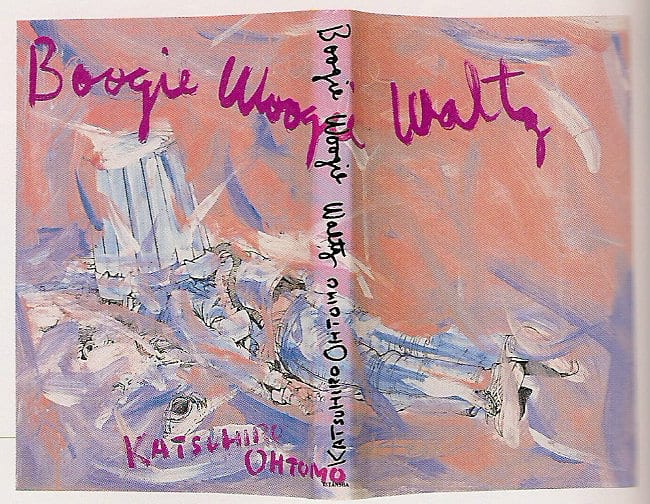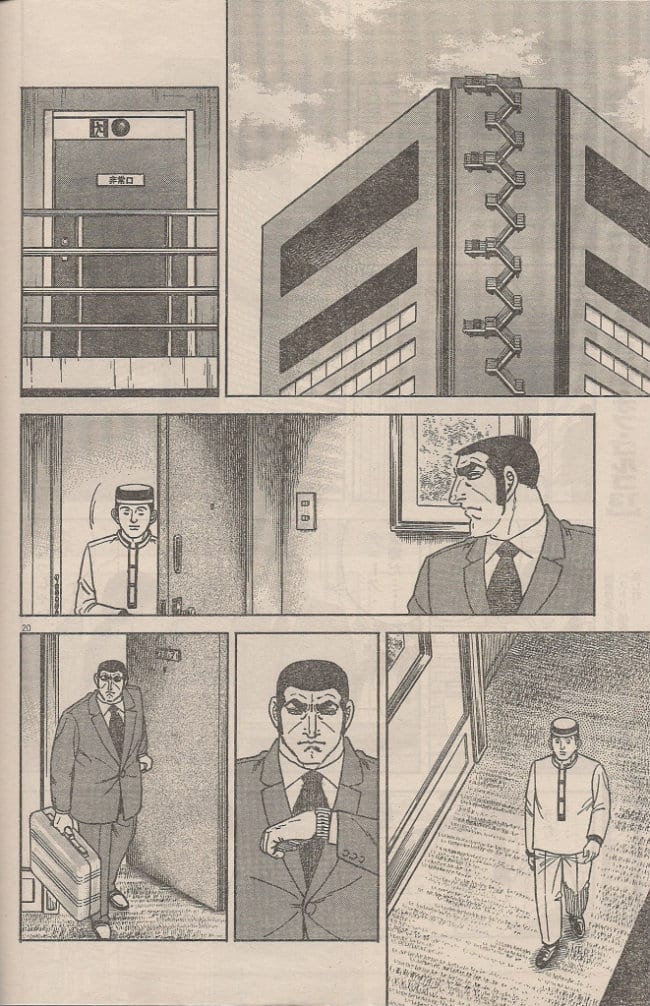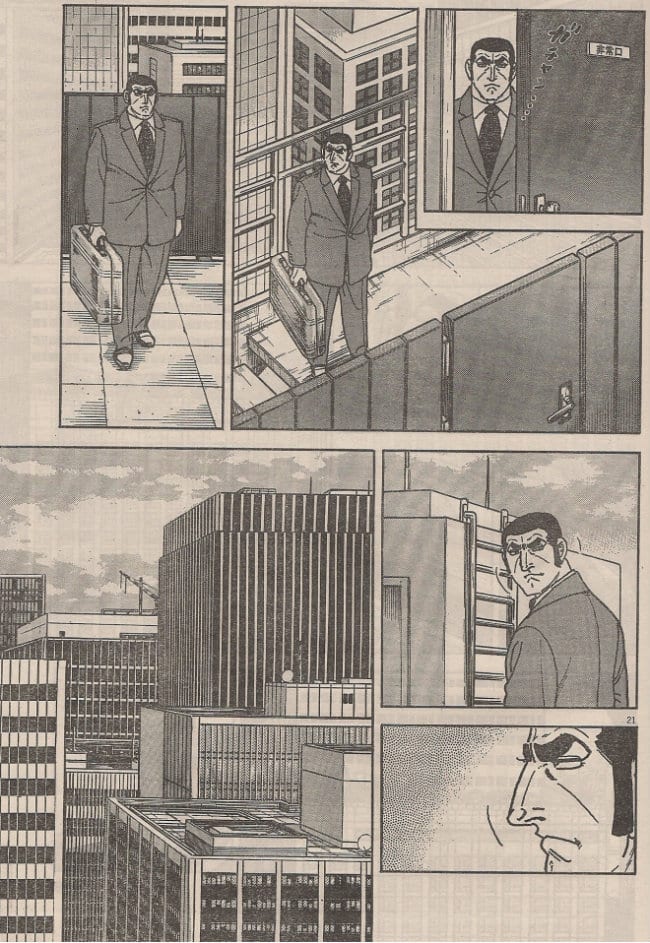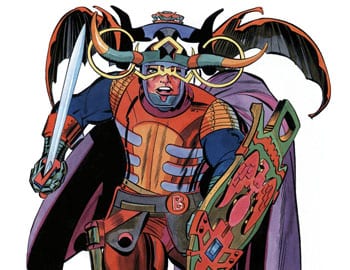So yeah, I teased you all last week with art that kind of worked in the same manner as Katsuhiro Otomo's, and now we see the man himself, via DJ Teck * Morning Attack, a new eight-page color comic Otomo created for the Japanese artist magazine Geijutsu Shincho as a centerpiece to an 83-page(!) feature on the artist its the April 2012 issue, which I just happened to obtain from the Kinokuniya bookstore in Manhattan prior to attending this year's MoCCA festival.
This is not to be confused with Otomo's upcoming period shonen series, his big return to longform comics after two decades of doing other stuff; the Geijutsu Shincho story is a special, akin to Otomo's framing sequence to the 1987 theatrical anime anthology Robot Carnival, in that it depicts the arrival of a colorful mechanical intruder -- here a guy in a happy mecha suit broadcasting peppy English-language phrases above its head -- with the result being a colorful annihilation of an indigenous people. One might suspect a certain critique of foreign adventurism in the suicide-style explosion depicted above, and that would be in keeping with the artist's point of view; active since 1973, Otomo was part of a wave of Western-influenced artists that challenged the traditional means of manga creation, but his idiosyncratic approach does not extend to any particular affinity for Western politics, as his Akira vividly demonstrates.
This is from 1980; excuse the fuzziness, but Geijutsu Shincho is bound like it's meant to stop a bullet. One of the great things about its long Otomo feature -- there's texts from a variety of authors, all in Japanese, of course -- is the scads of art samples from the first ten years of Otomo's career, which is to say everything prior to Akira, save for the 1980-81 esper mayhem serial Domu: A Child's Dream. Part of Otomo's idiosyncrasy is that he's apparently disinterested in seeing any of his earlier work presented in English, and so all we can read of his copious short stories and visual experiments is collected in the 1994/95 Mandarin Paperbacks/Random House Australia release of Memories, a tie-in to an(other) anime anthology (and not to be confused with the 1992 Epic Comics edition of Memories, which only contains the title story). It's a shame, really - wouldn't you want to read 1982's Boogie Woogie Waltz, just going by the visual departure of the cover art?
Oh, but I understand such hypothetical releases would be the the stuff of art comics kids and older-school otaku who remember Studio Proteus and "video comics"; as I've said before, Otomo doesn't seem to carry a lot of credit with today's manga readers or anime viewers. The newer, younger styles have outpaced him, though even a youth-friendly publisher like Viz has maintained its Viz Signature and SigIKKI lines of older-skewing books, many of the latter culled from the monthly Shogakukan seinen anthology IKKI, the June '12 issue of which I also happened to pick up.
Of its 440 pages, 8 are in color, including:
This is one half of a double-page spread for Sunny, the present serial by the great Taiyō Matsumoto, just now up to its second collected edition in Japan. It's tempting to see the Tekkonkinkreet creator as the inverse of Otomo, in that the younger artist works constantly at new manga, and wields a very brushy, sweeping, calligraphic style that evokes classical Japanese art.
However, both Otomo and Matsumoto share an individualism, eschewing the heavy use of art assistants, for the most part, to chase their personal visions. If the former had his days of glory in North America, though, the latter talent has proven to be a harder sell, despite the affections some circles hold for him. Tekkonkinkreet only broke through after multiple publication efforts and a high-profile anime film adaptation, and while I personally consider Viz's 2009 publication of GoGo Monster to have been the best domestic comics release of that year, it was met in manga/anime circles with varying degrees of coolness, and some outright mockery; I seriously doubt sales were very strong, and I don't expect to see anything of its sort released again from a 'mainstream' manga publisher in the immediate future.
And yet, despite it all, I am reminded that another world of comics exists, a popular, commercial world where artists toil on long-established properties in anonymity. Yet this too is not without its charms -- and its difficulties in translation -- as demonstrated by my childhood imaginary friend, super-assassin Golgo 13:
Such class and economy! It is my ritual, every MoCCA, to shell out the five bucks and change for the most recent issue of Big Comic ("Comics for Men"), and to see in its 330 or so pages what Golgo 13 is doing; he has always been doing something, in every single issue, since his strip debuted in 1969. Yet Golgo 13 is a creator-owned property, still maintained by early gekiga artist Takao Saito, age 75.
But the credit you'll see on Golgo 13 is "Saito-Pro," indicating that a production company of hirelings has been maintained -- as is part of Saito's regular process -- to actually produce a considerable amount of the content on the page; in Saito's case, this probably means everything but the characters' faces, if not everything full stop. Hence, the dizzying effect of those perfect skyscrapers, a staple of the feature, and almost certainly among the dedicated job duties of (let's say) Saito Pro Functionary #73, a guy or gal specializing in drawing background materials, probably from copious photo reference and file clippings.
Yet this is a tradition of quality, so you find sealed inside Golgo 13 a very direct, old-fashioned respect for storytelling clarity - a sobriety imposed by studio regulation. Even compared to the other middle-aged man-targeted Big Comic features -- a veterinary serial, samurai and crime dramas, fishing, cooking (lots of cooking) -- the Saito Pro work is dignified, though it is a dignity of people performing assigned work, of filling roles. Not everybody is going to call themselves a "creator" here, and fewer still will be profiled in a magazine, and here, perhaps, we see a fundamental disconnect between the searching, Western-informed aesthetic of Otomo and his predecessors, though Matsumoto demonstrates qualities of both: a continuing dedication to solitude and classicism, and the perils, I guess, of translation into foreign comics preferences, as Golgo 13 too has rarely found much of a place among English-translated manga.
And so I continue to peer onto these shelves, when I really should be downtown.
***
PLEASE NOTE: What follows is not a series of capsule reviews but an annotated selection of items listed by Diamond Comic Distributors for release to comic book retailers in North America on the particular Wednesday, or, in the event of a holiday or occurrence necessitating the close of UPS in a manner that would impact deliveries, Thursday, identified in the column title above. Not every listed item will necessarily arrive at every comic book retailer, in that some items may be delayed and ordered quantities will vary. I have in all likelihood not read any of the comics listed below, in that they are not yet released as of the writing of this column, nor will I necessarily read or purchase every item identified; THIS WEEK IN COMICS! reflects only what I find to be potentially interesting.
***
SPOTLIGHT PICKS!
Kiki de Montparnasse: And what better way to begin this week's slightly abbreviated tip sheet than with a tome from MoCCA exhibitor SelfMadeHero, a UK publisher only now seeing its 2011 English translation of a 2007 Casterman release from writer José-Louis Bocquet (also recently of Drawn and Quarterly's The Adventures of Herge) and artist Catel Muller distributed to Diamond-serviced North American comic book stores? It's 416 pages devoted to the life of the early 20th century Parisian artist's muse, winner of the audience-awarded Essentiel FNAC-SNCF at Angoulême 2008 (the book, not the muse). Reviewed by Hayley Campbell at this site; $24.95.
Fallen Words: This, in contrast, was a proper MoCCA debut, being publisher Drawn and Quarterly's sixth and newest release from Yoshihiro Tatsumi, a 264-page collection of very old stories adapted to comics from the oral tradition of rakugo. Apropos of nothing, chance and circumstance may have designated Tatsumi the official representative of the mid-century gekiga style for North American observation, but hints of the style's influence can be found elsewhere. For example, Discotek Media recently released a new R1 dvd edition of Panda! Go Panda!, a 1971-72 series of theatrical shorts from the eventual founders of Studio Ghibli, and while Hayao Miyazaki's character designs for the main cast are basically in keeping with the Ghibli 'look' (in a foundational sense), some of his periphery characters carry themselves in a rougher manner:
Seriously! Is that cop not Tatsumi as fuck? In an old-timey anime kinda way? Am I seeing things? Maybe Discotek's June release of the contemporaneous and more evidently older-skewing manga-derived Lupin III television series -- Miyazaki's directorial debut, albeit in collaboration with Isao Takahata -- will provide a missing link; $19.95.
--
PLUS!
The Bulletproof Coffin: Disinterred #4 (of 6): This is the 'cut-up' issue of my favorite superhero title at present, David Hine's & Shaky Kane's better-than-the-original sequel to their Image-published satire of comic book consumption, now focused harder than ever on the act of reading and falling into comic book genre narratives. I believe 84 individual drawn panels were composed discreetly by Kane, then assembled at random into 21 four-panel grids, representing fragments of 'lost' comics from the world of the series, and then scripted-over by Hine. Correct me if I'm wrong; I could be. The creators promoted their effort via a gala dis-assembly of a copy of Stan Lee's & Jack Kirby's Fantastic Four #2, reactions to which reminded me of the time Alan Moore exhorted readers of Promethea to physically pull apart the final issue of that series as participation in a ritual act of destruction/creation, the psychological effect upon myself being an odd relief of my completest tendencies. Of course, if everyone just bought two copies... Preview; $2.99.
Dial H #1: Actually, this is a pretty busy week for superhero stuff, and chief among several series debuts is writer China Miéville's revival of the Dave Wood/Jim Mooney concept of short-lived superpowers spurting from a mystery dial. The project is ongoing, and drops in close proximity to Miéville's imminent prose novel Railsea. The artist is Mateus Santolouco, and the (primary) cover is by Brian Bolland; $2.99.
X-O Manowar #1: Unless I am gravely mistaken, this is the first release from a revived Valiant Entertainment, bearing the name of the once hugely successful '90s alternative-mainstream publisher to continue exploitation of the various properties that remain so held. It is notable here for the presence of writer Robert Venditti, of various Top Shelf sci-fi projects such as The Surrogates and The Homeland Directive. The artist is Cary Nord. Preview; $3.99.
The Boys #66: Noteworthy as the beginning of the final storyline for Garth Ennis' & Darick Robertson's superheroes-as-weapons-of-a-hegimon worldbuilding playground/Bronze Age-y spandex soap opera, the unevenness of which is exemplified here by the now-presumed absence of Robertson from active interior participation (Russ Braun fills in, as he often does). Unfortunately, the catch-as-catch-can state of the series' art may yet go down as its most convincing evocation of the present superhero scene. Preview; $3.99.
Fury MAX #1: Meanwhile, Ennis begins a new Marvel project under the Mature Readers MAX banner, which appears to be reserved specifically for his presence these days. The artist is Goran Parlov, which suggests a series set in the world of Ennis' The Punisher MAX, if likely the more comedic zone of the Barracuda side-story. Nick Fury, that pliable Lee & Kirby creation, will defend America for an indeterminate length as of this writing, though be aware that issue #2 should be out later this month, and issue #4 will apparently involve the assassination of Fidel Castro, or perhaps a good faith attempt, or certainly at minimum an attempt; $3.99.
Action Comics #9: Kind of a three-in-one, multi-story, possibly standalone installment of Grant Morrison's ongoing Superman project, concerning in some part the President Superman character from toward the end of Final Crisis and sporting another special appearance by the welcome Gene Ha. Small sample; $3.99.
Skeleton Key Color Special: Dark Horse has been quietly but steadily slipping out comic book compilations of shorts from its newest Dark Horse Presents anthology, and this particular exhibit constitutes a revival for an Andi Watson concept dating back to the mid-'90s with SLG, concerning a girl with a key that unlocks alternate dimensions, and the fox spirit that accompanies her. Drawn in a very cute monochrome color manga-ish style. Preview; $3.50.
Spirit World: And here's some choice Jack Kirby reprints, specifically a 108-page hardcover compilation of materials composed for DC's 1971 entry in the b&w comics magazine sweepstakes -- intended by Kirby to be a slick color affair, which the publisher found to be too costly -- chock-full of drawings, collage, fumetti and Sergio Aragonés, at least for its sole extant issue. The remaining stock was eventually distributed in color to issues of the anthology titles Weird Mystery Tales and Forbidden Tales of Dark Mansion, and I believe that's the format it'll be seen in here. History; $39.99.
Tangles: A Story About Alzheimer's, My Mother and Me: But it's not all fantasy, no - here's a new entry on the comics memoir scene, a Skyhorse Publishing edition of a 2010 Canadian graphic novel from artist Sarah Leavitt, concerning the affects of disease on her family; $14.95.
Heavy Metal Vol. 36 #2 (May 2012): Finally, here is the official 35th Anniversary issue of the newsstand Eurocomics institution, reprinting the original Jean-Michel Nicollet cover to 1977's issue #1 with three variant 'cover' versions. Inside we are promised work by the late Moebius, along with François Boucq, Miguelanxo Prado, Tanino Liberatore, Paolo Serpieri, Matthias Schultheiss (haven't seen him in a while), Alfonso Azpiri, Massimiliano Frezzato, and others. I am unaware if any (or all) of this content is reprinted, but a lineup like that does encourage some perusal; $7.95.
--
Ah, there we go. Another column for the books. Thank you, and good morning.


















